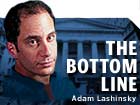
PALO ALTO, Calif. (CNN/Money) -
Here's a sign of the times: A Wall Street brokerage is proud of going negative.
That's right, Morgan Stanley now wants you to know it's the house with the fewest nice things to say about the stocks it covers. According to the firm, 22 percent of its covered stocks are rated "underweight," the rhetorical equivalent of a sell.
"That's more than all other Wall Street firms combined," crows a spokeswoman in an e-mail to journalists who follow Wall Street. (She attributes to Bloomberg News the assertion that Morgan Stanley's negative picks outdo the rest of the industry taken together.)
For a contrarian like me, it's the best sign I've seen yet that the market is ready for a real rally.
Morgan Stanley, after all, may be fighting the last war, getting negative when times are tough after having been positive when times were good. The firm, you will remember, had its share of bubble-era dust-ups. Although Merrill Lynch is on the hot seat now, remember that it was Morgan's Mary Meeker who did a star turn as Fortune magazine's cover girl for analyst conflicts a year ago.
There's no arguing, of course, that its new ratings are clearer than the alpha-numeric gobbledygook other firms use. It has just three now: Overweight, equal-weight and underweight. They've been around since March 18, and currently 33 percent of the firm's stocks are overweight, while 45 percent are equal-weight.
One wonders how this skepticism compares with past ratings, before the easy-to-understand labels of today. "We have been open about saying it was nowhere near 22 percent," spokeswoman Diana Quintero told me. She adds that the Securities Industry Association asked Wall Street firms a year ago to be transparent about what their ratings mean. "We do," she says.
I suppose it's somewhat encouraging just to see a big firm trumpeting its objectivity. Of course, deal activity is at its worst level since 1996 -- it'll be more interesting to see how negative Morgan Stanley (and the rest of the Street) is when there's banking business to be had again.
Did you really mean to say that?
An interesting ad appears in the current issue of Fortune. It's an attack by Danish software maker Navision reminding customers that it is the No. 1 alternative to Microsoft's Great Plains software.
| |
 RECENTLY BY ADAM LASHINSKY
RECENTLY BY ADAM LASHINSKY
| |
| | |
| | |
|
The text ad carries a banner headline that reads, "Don't let Great Plains operate on the heart of your business without a second opinion from Navision."
Just one problem: Microsoft agreed on May 7 to shell out $1.3 billion to buy Navision, and to integrate it with its Great Plains unit. I bet Microsoft would rather not have the Justice Department (or state prosecutors, or the judge, for that matter) reading a big, expensive ad from its erstwhile competitor claiming to be the No. 1 way to avoid buying Microsoft.
Adam Lashinsky is a senior writer for Fortune magazine. Send e-mail to Adam at adam_lashinsky@timeinc.com.
Sign up to receive The Bottom Line by e-mail.

|

